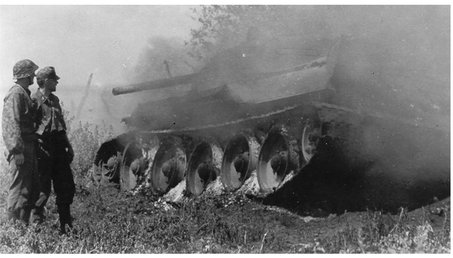Chapter Nine
Hitler’s Ukrainian Nazis
Following the utter destruction of Hitler’s Army Group Centre in Byelorussia in June 1944, Stalin instructed Marshal Georgi Zhukov to coordinate his next massive counteroffensive to be conducted by Marshal I.S. Konev’s 1st Ukrainian Front. Sitting in Konev’s path ready to counter-attack were some 20,000 crack Ukrainian SS troops who had thrown in their lot with Hitler.
Many Ukrainians hoped they would gain independence from Moscow by helping Hitler’s war machine.The Ukrainian Liberation Army (Ukrainske Vyzvolne Viysko–UVV) was little more than a Nazi propaganda tool, and two Ukrainian divisions numbering 40,000 men designated the Ukrainian National Army (UNA) in 1945 was never really effective as such.
Significantly, Ukrainians proved eager recruits for a Waffen-SS division.These were largely Galician Ukrainians, as Reichsführer Heinrich Himmler stipulated they must come from the western Ukraine (formerly Polish Galicia) and be Greek Catholic rather than Russian Orthodox, thereby barring Soviet Ukrainians. The idea was that anti-communist volunteers would be drawn from the area of Poland that had once been part of the Austro-Hungarian Empire and therefore loyal servants of the Habsburg Emperor.
When recruitment commenced in April 1943 there were a staggering 100,000 applicants for 30,000 places (typically a Waffen-SS division numbered about 15,000 fighting men and 5,000 support troops). Many of the others were not turned away and were recruited to form five Galician police regiments. Himmler placed an Austrian Major-General, the elderly and professorial-looking Fritz Freitag in charge. About 350 Galician volunteer officers and 2,000 NCOs were despatched to Germany. After their training was completed in May 1944, the 14th Waffen-SS Grenadier Division Galizien was shipped to the Eastern Front just in time to face Konev’s Lvov-Sandomierz offensive.
North of Lvov the 3rd Guards Army and 13th Army, 1st Guards Tank Army and General V.K. Baranov’s mechanised cavalry corps were to strike in the direction of Rava-Russkaya and the 4th Panzer Army. In the south the 60th and 38th armies, plus the 3rd Guards and 4th Tank armies and General S.V. Sokolov’s mechanised cavalry group were to push on Lvov, cutting their way through the 1st Panzer Army. Even further south the 1st Guards and 18th armies, with the 5th Guards Army following up were to attack the weak Hungarian 1st Army guarding the approaches to Stanislav.
Resistance by the 1st and 4th Panzer armies was much better than that conducted by Army Group Centre’s shattered armies. Konev threw his tanks in a two-pronged attack: the right forced its way across the Bug and headed north for Rokossovsky’s planned push on Lublin and the Vistula; but panzer and SS divisions initially held up his left as it fought its way south towards Lvov. The northern attack ran into the prepared positions of the weak 291st and 340th Infantry Divisions, but these were easily penetrated. To the north-west into the gap either side of Radekhov Konev poured Cavalry-Mechanised Group Baranov and the 1st Guards Tank Army. It took the 13th Army two days of tough fighting to surround Brody.
With his defences east of Lvov just about holding, General Harpe decided to commit his tactical reserves, the 1st and 8th Panzer Divisions, in an attempt to stifle the Soviet offensive on 14 and 15 July. Although Konev had been ordered by Stalin to hold back the 3rd Guards and 4th Guards Tank armies until a deep penetration had been made, he knew he must act quickly to exploit the situation.
Konev had trouble bringing his tank armies to bear in the Lvov attack because the 15th Infantry Corps from 60th Army had only managed to hack a 2.5- to 4-mile-wide corridor to a depth of 11 miles. General P.S. Rybalko, commander of the 3rd Guards Tank Army took the decision to shove his men down this corridor on the 16th and was followed up by General D.D. Lelyushenko’s 4th Tank Army.
This was the only time during the war that two entire tank armies were committed to combat on such a narrow front, and while the flanks were being counter-attacked. With German artillery bombarding this ‘Koltiv Corridor’, the 1st and 8th Panzer Divisions prepared to counter-attack supported by Freitag’s Ukrainian 14th SS.
Once Rybalko’s men were in the corridor, General Arthur Hauffe’s German 13th Corps knew it must withdraw and fell back to the Prinz Eugen Stellung defensive position. By the 17th the Soviets had captured parts of this strongpoint, which Freitag’s Galician Ukrainians attempted to recapture until the appearance of powerful Soviet IS-2 tanks. On the evening of 18 July the 1st Ukrainian Front cut through Harpe’s defences to a width of 125 miles, advanced 30 to 50 miles and surrounded 45,000 men near Brody. Despite pleas to General Hauffe by his subordinates, there was little he could do to help the four divisions in the Brody salient escape.
The 48th and 24th Panzer Corps attempted to reach 13th Corps but to no avail. On the 18th Von Mellenthin, taking command of 8th Panzer, tried to cut his way through to the trapped men of the 13th Corps at Brody. The Soviets were waiting for him with minefields and concentrated artillery and tank fire. Mellenthin remembers:
Two days later the bulk of 13th Corps, led by Generals Lasch and Lange, succeeded in fighting their way through to our lines. Thousands of men formed up in the night in a solid mass and to the accompaniment of thunderous ‘hurrahs’ threw themselves at the enemy. The impact of a great block of desperate men, determined to do or die, smashed through the Russian line, and thus a great many of the troops were saved. But all guns and heavy weapons had to be abandoned, and a huge gap was opened in the front. Marshal Konev’s tanks poured through and the whole German position in southern Galicia became untenable.
Those forces remaining in the Brody pocket resisted for four miserable days until it was cut in half and they were finally wiped out on the 22nd. The Germans suffered 30,000 killed and 15,000 captured as well as losing sixty-eight panzers, 500 guns and 3,500 lorries.
Unable to resist the Soviet tanks, 14,000 men of Freitag’s 14th SS Division were caught in the Brody area and just 2,000–3,000 managed to escape. Those caught could expect little leniency from their captors. Despite the severe mauling of his untested division there was no doubting Freitag’s courage and he was decorated with the Knight’s Cross. His exhausted survivors were sent to Slovakia to refit and the division was rebuilt using Soviet Ukrainians, which was reflected in its re-designation to 14th SS Grenadier Division (ukrainische Nr.1 ). They were not redeployed until 1945 and then fought in Czechoslovakia and Yugoslavia.
The Soviet summer 1944 offensive saw the Red Army cut through the Ukraine and into Poland to the very gates of Warsaw: this spelled the end of Bulgaria, Finland, Hungary, Romania and Slovakia’s alliance with Hitler. Once they had become frontline states they were swift to swap sides; by this stage, though, most of their tank forces had been destroyed.
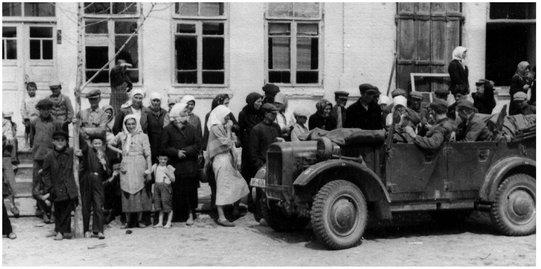
When Hitler’s forces rolled into the Ukraine in June 1941, in many instances they were greeted as liberators by the locals. However, he had no intention of granting the Ukrainians independence and threw away a golden opportunity to unravel the Soviet Union. This propaganda shot shows German troops fraternising with smiling Soviet civilians. The 4x4 staff car is a universal light cross-country vehicle built by Stoewer, BMW and Hanomag, and known as the Kfz.1.
SS divisions were equipped with the standard 50mm and 75mm anti-tank guns of the day. These Waffen-SS gunners appear to be operating a Pak 40 75mm.
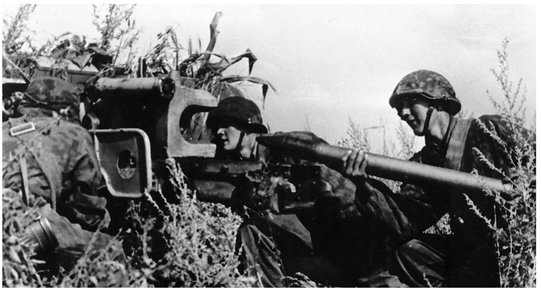
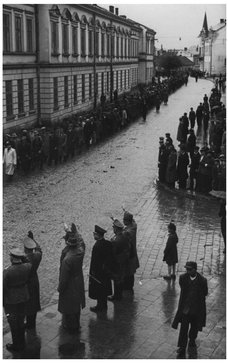
Ukrainian volunteers parade past Nazi officials. Moscow swiftly branded them as traitors who were to be shot on sight.
When recruitment started for a Ukrainian Waffen-SS Grenadier Division 100,000 volunteers came forward.
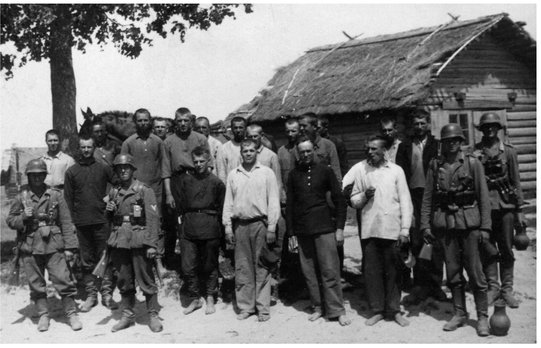
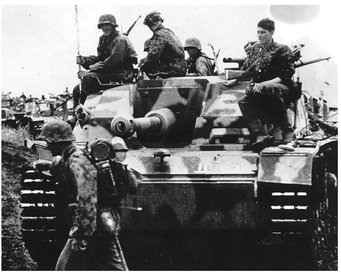
On the Eastern Front the Waffen-SS panzergrenadier and infantry divisions were reliant on the assault gun battalions for armoured support. The Sturmgeschütz III was a highly versatile weapon and was deployed throughout the Waffen-SS and not only in the panzer divisions. It tended to be deployed with the artillery regiments due to its role as mobile assault artillery. The two shots show Waffen-SS in their very distinctive camouflage smocks hitching a ride to the front on StuG IIIs.
While some of the much better-known mixed-nationality foreign volunteer Waffen-SS divisions such as the Danish and Dutch 5th SS Panzer Division Viking, the Austrian and Romanian 7th SS Freiwilligen Gebirgs Division Prinz Eugen, Austrian and Slovenian 16th SS Panzergrenadier Division Reichsführer-SS and the Belgian 28th SS Panzergrenadier Division Wallonien were equipped with considerable numbers of armoured fighting vehicles, the Ukrainian 14th SS Grenadier Division Galizien was not and suffered as a consequence. In addition, these other units were fleshed out with ethnic German officers, NCOs and recruits.
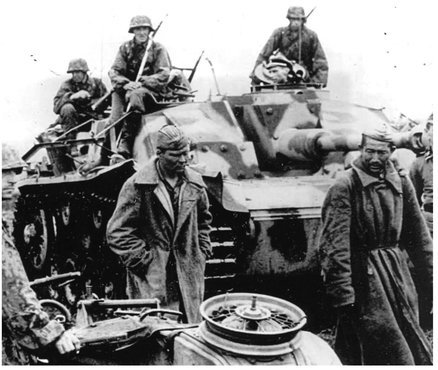
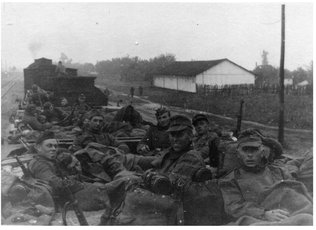
The 14th Waffen-SS Grenadier Division Galizien shipped to the front in May 1944 just in time to meet the Red Army’s Lvov-Sandomierz offensive.The Ukrainians found themselves deployed right in the path of a major Soviet tank attack.
A Waffen-SS anti-tank gunner. To fend off Soviet tanks the Ukrainian infantry would have been issued with the Panzerfaust or ‘armoured fist’ hand-held single-shot anti-tank weapon seen here. While it could penetrate up to 140mm of plate armour, its effective range was only 30 metres. It took strong nerves to face down a tank at such ranges.
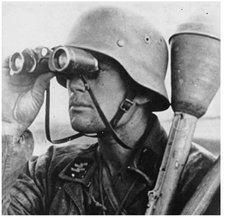
While the Waffen-SS were permitted to flesh out rather poorly-performing panzer divisions using Austrian, Belgian, Hungarian, Romanian, Slovenian and Scandinavian recruits, it was probably felt unwise to equip a Ukrainian SS division with tanks.The unit’s sole armoured formation was the Waffen-SS Panzerjager Company 14 equipped with self-propelled anti-tank guns such as the Marder. They stood little chance in the face of hordes of Soviet T-34s.
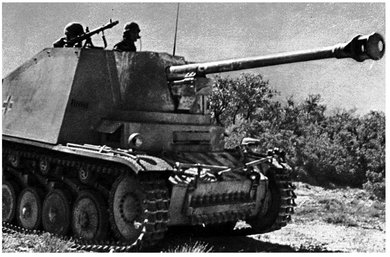
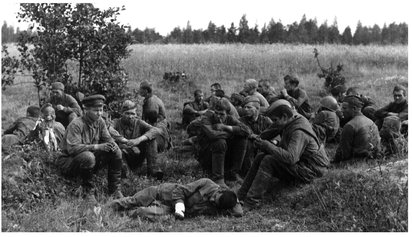
Soviet troops behind the lines during a lull in the fighting. Collaborators were either shot on the spot or shipped to the Gulag.
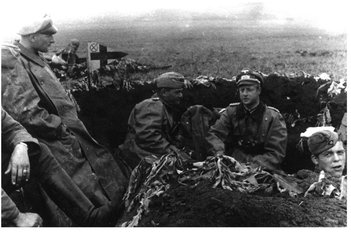
German officers conferring in freshly-dug trenches. Around 40,000 troops including the 14th SS were trapped in the Brody pocket–only about 3,000 Ukrainians escaped.
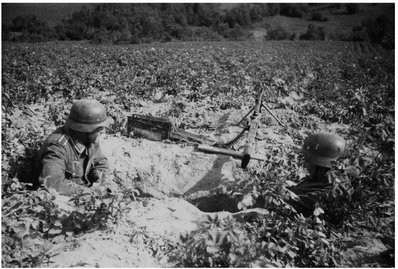
General Harpe’s Army Group created three main defensive belts in western Ukraine 19 miles deep. It was hoped that this would be enough to stop Stalin’s tanks.
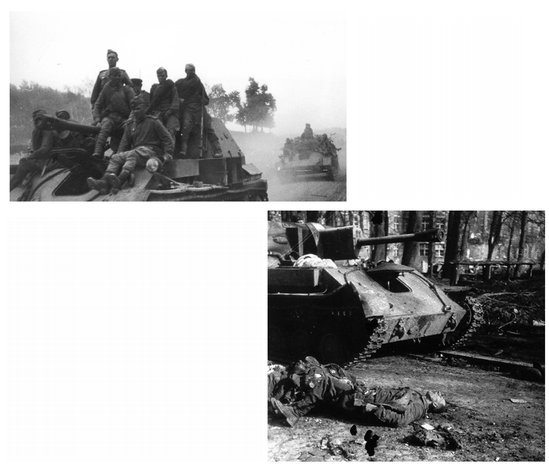
The first photo shows Soviet SU-76 self-propelled guns moving up for the Red Army’s summer offensive in 1944. The second image shows the harsh realities faced by the Ukrainians in trying to overcome even lightly-armoured vehicles such as the SU-76. The Ukrainian troops trying to resist their Russian cousins ended up trapped in the Brody pocket.
Two members of the Waffen-SS look on at a burning T-34/85–the Ukrainians had no real ability to fight off large numbers of this highly effective tank. In reality the 14th SS Grenadier Division was just a sop to Ukrainian national aspirations, which Hitler had no intention of helping them fulfil. The result was that the division lost up to 10,000 men killed or captured by the vengeful Red Army. Unlike Hitler’s other Eastern Front allies in the closing months of the war, Ukrainian nationalists had nowhere to run to–the survivors could not retreat home, because home was part of the Soviet Union. Many sought sanctuary in the Ukraine’s forests but were eventually hunted down and shot. Ultimately all of Hitler’s allies suffered because of their inability to conduct effective armoured warfare on the Eastern Front. Stalin’s armoured blitzkrieg swept all before it.
